Related Research Articles

Diego Rodríguez de Silva y Velázquez, Knight of the Order of Santiago was a Spanish painter, the leading artist in the court of King Philip IV of Spain and Portugal, and of the Spanish Golden Age.

Bartolomé Esteban Murillo was a Spanish Baroque painter. Although he is best known for his religious works, Murillo also produced a considerable number of paintings of contemporary women and children. These lively realistic portraits of flower girls, street urchins, and beggars constitute an extensive and appealing record of the everyday life of his times. He also painted two self-portraits, one in the Frick Collection portraying him in his 30s, and one in London's National Gallery portraying him about 20 years later. In 2017–18, the two museums held an exhibition of them.

Matteo Pérez de Alesio (1547–1628) was an Italian painter of devotional, historical and maritime subjects during the Mannerist period. He was also known as Matteo da Lecce by virtue of his hometown of Lecce. He spent the majority of his entire artistic career in Peru, where he lived more than 40 years, between 1588 and 1628.

Francisco de Zurbarán was a Spanish painter. He is known primarily for his religious paintings depicting monks, nuns, and martyrs, and for his still-lifes. Zurbarán gained the nickname "Spanish Caravaggio", owing to the forceful use of chiaroscuro in which he excelled.

The Spanish Golden Age is a period of flourishing in arts and literature in Spain, coinciding with the political rise of the Spanish Empire under the Catholic Monarchs of Spain and the Spanish Habsburgs. The greatest patron of Spanish art and culture during this period was King Philip II (1556–1598), whose royal palace, El Escorial, invited the attention of some of Europe's greatest architects and painters such as El Greco, who infused Spanish art with foreign styles and helped create a uniquely Spanish style of painting. It is associated with the reigns of Isabella I, Ferdinand II, Charles V, Philip II, Philip III, and Philip IV, when Spain was the most powerful country in the world.

Francisco Pacheco del Río was a Spanish painter, best known as the teacher and father-in-law of Diego Velázquez and Alonzo Cano, and for his textbook on painting, entitled Art of Painting, that is an important source for the study of 17th-century practice in Spain. He is described by some as the "Vasari of Seville": vocal and didactic about his theories of painting and thoughts about painters, conventional and uninspired in his executions.

Francisco Herrera (1576–1656) was a distinguished Spanish painter, born in Seville. He was the founder of the Seville school.

Spanish art has been an important contributor to Western art and Spain has produced many famous and influential artists including Velázquez, Goya and Picasso. Spanish art was particularly influenced by France and Italy during the Baroque and Neoclassical periods, but Spanish art has often had very distinctive characteristics, partly explained by the Moorish heritage in Spain, and through the political and cultural climate in Spain during the Counter-Reformation and the subsequent eclipse of Spanish power under the Bourbon dynasty.

Sebastián de Llanos y Valdís was a Spanish painter of the Baroque period, mainly active in Seville.
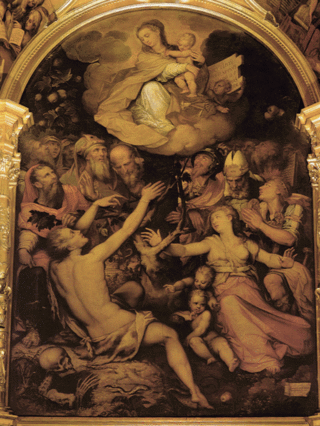
Luis de Vargas (1502–1568) was a Spanish painter of the late-Renaissance period, active mainly in Seville. He traveled to Rome where he was influenced by Mannerist styles. He painted an altarpiece with multiple panels, including a Virgin and Child appearing to Adam and Eve or La Gamba for the Cathedral in Seville. He frescoed a Last Judgement for the Casa de Misericordia in Seville. Francisco Venegas was a student of his.
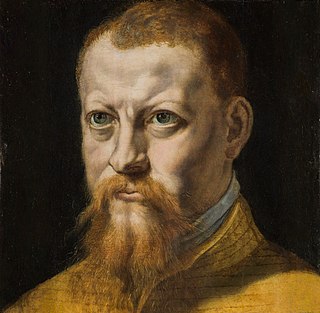
Pedro Campaña (1503–1586) was a Flemish painter of the Renaissance period, mainly active in Italy and Spain. His actual name was Pieter de Kempeneer, translated into French as Champaigne, and was also known as Peter van de Velde.
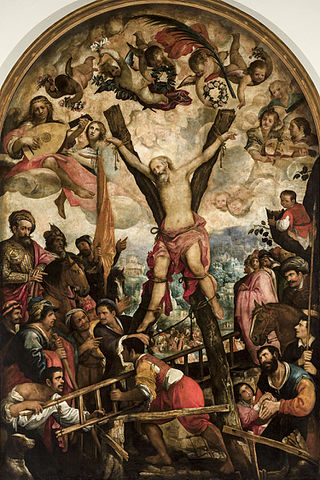
Juan de Roelas, de las Roelas or Ruela was a Flemish painter whose entire documented career took place in Spain. He played a major role in the transition from Mannerist to Baroque painting in Spain.
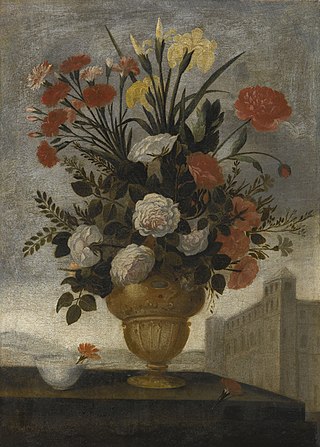
Pedro de Camprobín Passano was a Spanish Baroque painter who specialized in still-lifes; primarily flowers.
Francisco López Caro (1578–1662) was a Spanish painter of the Baroque period. Born in Seville, he was a pupil of Juan de las Roelas. We know very little of him, save that he painted with indifferent success in Seville until about 1660, when he went to Madrid where he spent the remainder of his life, and died in 1662. His works were mainly portraits, some of which are in private collections in Madrid, Salamanca, Granada, and Seville.
Francisco Herrera the Younger was a Spanish painter and architect.

The title of Hijo Predilecto de Andalucía or in the case of a female recipient Hija Predilecta de Andalucía is an honorific title granted annually on August 10 according to decree 156/1983 of the Andalusian Autonomous Government, recognizing exceptional merit or distinction in relation to the Andalusian region, through scientific, social or political actions or works that have redounded to the benefit of Andalusia. It is the highest distinction of the autonomous community of Andalusia.

Francisco Antolínez de Sarabia (1645–1700) was a historical and landscape painter who studied in the school of Murillo, whose style and manner of colouring he followed.
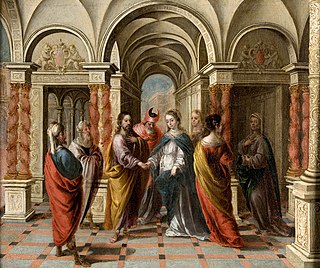
Matías de Arteaga y Alfaro, also Matias de Arteaga, was a Spanish painter and engraver.

Saint Apollonia is a 1636 oil-on-canvas painted by the Spanish artist Francisco de Zurbarán. It is currently held and exhibited at the Louvre in Paris.

Francisco Varela, was a Spanish Baroque painter.
References
- Bryan, Michael (1889). Walter Armstrong; Robert Edmund Graves (eds.). Dictionary of Painters and Engravers, Biographical and Critical. Vol. II L-Z. London: George Bell and Sons. p. 364.